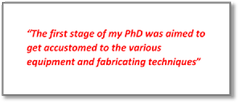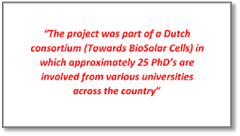 In this thesis new alternatives are investigated for silicon to take part in future photovoltaic (PV) cells and in solar-to-fuel (S2F) devices. Pillared solar cells showed an improvement when compared to current flat solar cells. ‘Because of the 3D-structure, this was an expected result,’ Rick Elbersen says. Radial p/n junctions were formed by different methods. Junctions were formed homogeneously over the full length of the pillars. Then pillars and junctions were further optimized. ‘Passivating and anti-reflective coatings can function as a chemically protective layer here,’ Elbersen adds. ‘This increases the stability of silicon in an aqueous environment, making silicon a serious candidate to perform in future water splitting devices as well.’
In this thesis new alternatives are investigated for silicon to take part in future photovoltaic (PV) cells and in solar-to-fuel (S2F) devices. Pillared solar cells showed an improvement when compared to current flat solar cells. ‘Because of the 3D-structure, this was an expected result,’ Rick Elbersen says. Radial p/n junctions were formed by different methods. Junctions were formed homogeneously over the full length of the pillars. Then pillars and junctions were further optimized. ‘Passivating and anti-reflective coatings can function as a chemically protective layer here,’ Elbersen adds. ‘This increases the stability of silicon in an aqueous environment, making silicon a serious candidate to perform in future water splitting devices as well.’
Building micropillars using current silicon wafers, is an exciting quest to further improve the yield and efficiency of solar cells. In this thesis standard UV photolithography and deep reactive ion etching were used to fabricate the micropillars.

‘The first stage of my PhD was aimed to get accustomed to the various equipment and fabricating techniques,’ Rick Elbersen says. ‘I learned to gain experience, better controlling temperature ranges and etching time frames. Also characterizing equipment was involved, such as the use of a focused ion beam and scanning electron microscopy. Further, sputtering techniques were used, to fabricate an ohmic contact which was needed for electrical characterization.’
Optimum pillar height and junction depth
Both in phosphorous and boron-doped samples, the pillared solar cells showed an improvement in efficiency. By varying the height of the pillars, Elbersen found the highest solar cell efficiency for pillars 40 µm in height. The optimum for the junction depth was found to be 790 nm, for pillars with a diameter of 4 µm.

Elbersen: ‘During the characterization experiments, I used the sunlight simulator, including standardized filters, of the PhotoCatalytic Synthesis Group, led by Professor Guido Mul, here at MESA+. An improvement of light absorption could be shown as well, thus confirming simulation runs performed beforehand.’
Anti-reflective coating
Further optimization of solar pillar devices was found by means of a passivation and anti-reflective coating. For both p- and n-type doped samples, atomic layer deposition of Al2O3 gave the highest increase in solar cell efficiency. In the final chapter axial p/n junctions were fabricated, in contrast to the radial junctions in the previous chapters.
‘Four publications appeared from my work, including Advanced Energy Materials and Advanced Materials journals,’ Elbersen says. ‘The first publication dated November 2014. The base technology and micropillars were solid by then. After this publication, I was confident the other aspects of my work were suited for publication as well.’

Patents regarding this technology are not relevant at this very moment, Elbersen explains. ‘First applications are attractive in about twenty years from now, I reckon. The aim now was to prove efficiency improvements are actually possible, and the bottlenecks on further developing this approach were looked for. The project was part of a Dutch consortium (Towards BioSolar Cells) in which approximately 25 PhD’s are involved from various universities across the country. Within MESA+ my work is taken further, focusing on the anti-reflection layers using my platforms. It was great handing over this work to the new PhD candidate.’
Risk assessment
Rick Elbersen himself is happy to make a switch towards a different working environment. ‘Within a small enterprise company, I will be focusing on risk assessment analyses within chemical, construction and medical industry environments. The skills I developed during my PhD work will be beneficial, I am sure of. In depth studying literature, carefully defining main processes, managing complex parallel projects and reporting my findings are among those.’
